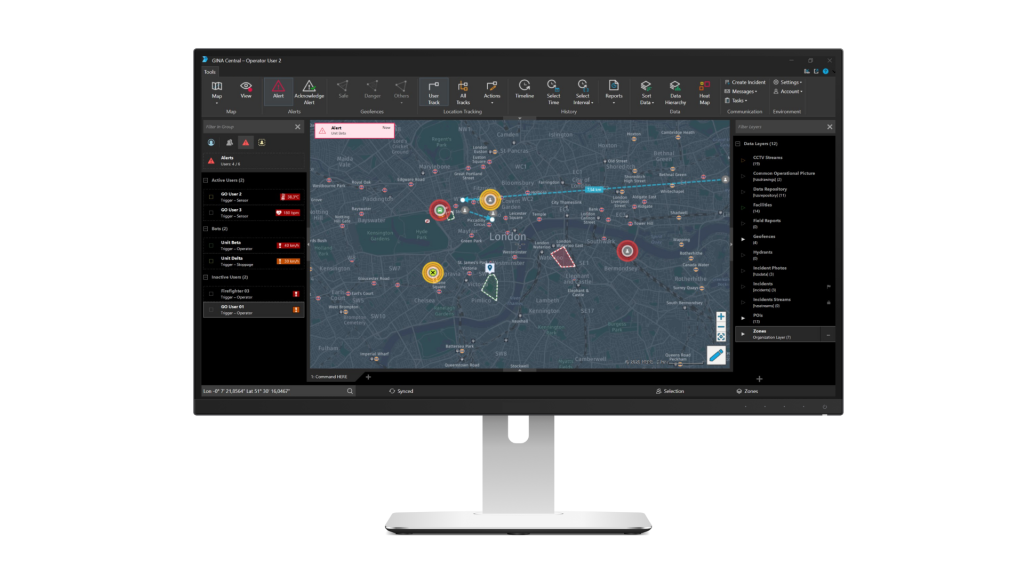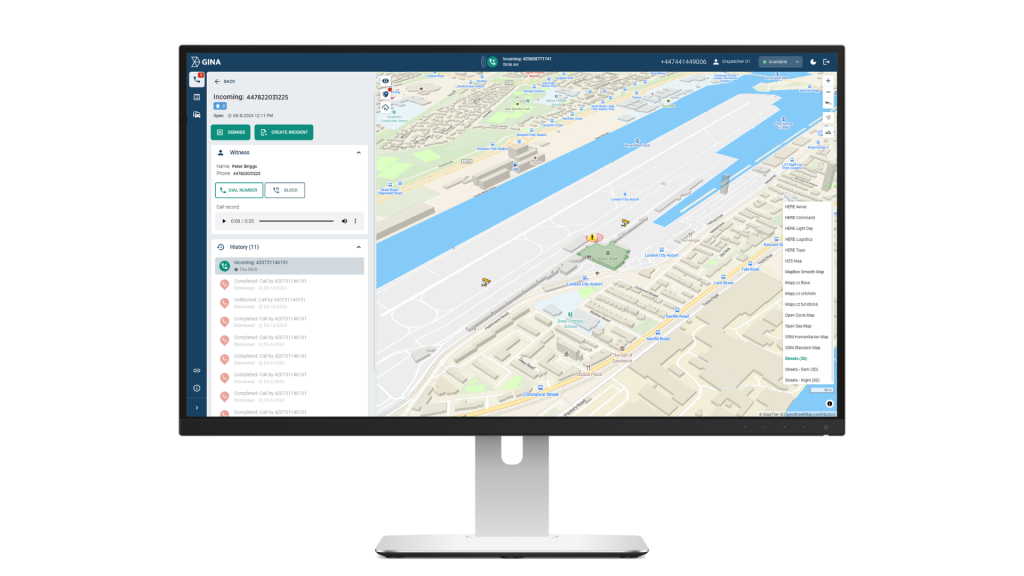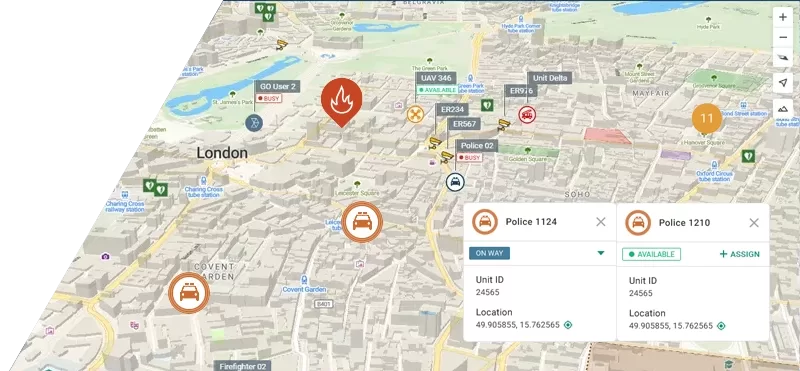Public Safety Answering Points (PSAPs) are the first line of communication between the people in distress and emergency services. In this article, we take a look at the meaning of PSAP, its functions, and the technologies shaping the future of public safety answering points.
Table of Contents
What is a PSAP?
A Public Safety Answering Point (PSAP) is a call center responsible for receiving emergency calls, dispatching the appropriate emergency services, and coordinating response.
PSAPs are the front line of emergency response, serving as the initial bridge between the public and critical services during distress situations. Public Safety Answering Points play a key role in managing a broad spectrum of incidents, from active crimes and medical emergencies to fires and large-scale natural disasters.
Once a distress call is received, PSAP personnel, typically a call taker or dispatcher, gather essential information about the emergency and ensure that the appropriate responders are dispatched. These may include fire departments, emergency medical services (EMS), law enforcement agencies (such as the police), or a combination of these.
PSAPs and NENA Association
In the United States, the NENA (National Emergency Number Association) organization plays a pivotal role in supporting Public Safety Answering Points (PSAPs) by setting national standards for 911 operations and technologies.
NENA, the 9-1-1 Association, is a non-profit organization that provides guidelines for call handling, dispatch protocols, and the implementation of Next Generation 911 (NG911) systems, developed voluntarily by public safety and industry experts.
Through training, certification, and advocacy, NENA helps PSAPs stay aligned with evolving public safety needs and emerging communication technologies.
Explore our article highlighting the importance of NENA in the 911 system for more information.
How PSAPs Work
When someone dials an emergency number, such as 911 in the United States, the call is routed to a Public Safety Answering Point (PSAP) based on the caller’s location. This location is typically determined through a combination of cellular tower triangulation, GPS data, and database lookups such as Automatic Number Identification (ANI) and Automatic Location Identification (ALI).
Once the call reaches the PSAP, trained operators (call takers) quickly gather critical information, including the nature of the emergency, the exact location, and any potential risks to the caller or responders. Using specialized tools, they assess the situation in real time and determine which emergency services (police, fire, EMS, or a combination) need to be dispatched.
This process is called call handling, and we break it down in more detail in an article dedicated to call handling in emergency services.
Answering distress calls must be carried out swiftly and accurately under high-pressure conditions, often while handling multiple calls and coordinating with field units. Increasingly, PSAPs are also equipped to process text messages, images, videos, and data from sensors, adding new dimensions to modern emergency response capabilities.
What is the difference between PSAP and dispatch?
While the terms PSAP and dispatch are often used interchangeably, they refer to different stages in the emergency response process.
A Public Safety Answering Point (PSAP) is the facility that first receives the emergency call and is responsible for answering, assessing, and gathering key information from the caller. Once the necessary details are collected, the PSAP may then transfer the call to a dispatch center or pass the information to in-house dispatchers.
Dispatch refers specifically to the process of assigning and coordinating emergency responders such as police, fire, or EMS units to the scene.
In some systems, the PSAP also handles dispatching, while in others, the two roles are handled by separate teams or agencies.
Core Technologies Supporting PSAPs
Part of every Public Safety Answering Point is a robust network of interconnected technologies. These systems streamline workflows for telecommunicators, improve response times, and ensure the seamless transfer of information between public, response agencies and field responders.
Below is a list of key technologies commonly used by PSAPs. Some are delivered as standalone appliances, while others are part of integrated solutions, such as Computer Aided Dispatch (CAD) systems, which typically include not only dispatch functionality but also features for call-taking, coordination, logging, and more.
Computer Aided Dispatch (CAD) software
CAD systems form the digital backbone of many PSAPs. They allow call-takers to record call information, track incidents, dispatch response units based on location and availability, and maintain communication with field personnel. CAD platforms often integrate with GIS, radio systems, RMS (Records Management Systems), and mobile data terminals (MDTs).
Read the following article about Computer Aided Dispatch to understand its features, use cases, and benefits.
Geographic Information Systems (GIS)
GIS provides real-time mapping and spatial awareness to dispatchers. By visualizing the caller’s location, available units, and other information on PSAPs displays, GIS supports accurate decision-making. GIS is also crucial for NG911 implementations, where precise location data is required.

Call Handling Equipment
Call-taking systems or call processing equipment, enables the reception and management of emergency voice calls, text-to-911, and multimedia communications.
It typically includes functions like Automatic Number Identification (ANI), Automatic Location Identification (ALI), call transfer, and conferencing. Call-taking is typically included as part of modern CAD software, such as Smart CAD by GINA.

Record Management Systems
Records management systems in modern Public Safety Answering Points (PSAPs) capture and preserve all incident-related communications and data across telephony, radio, and digital channels. They provide a time-stamped, secure audit trail of 911 calls, radio transmissions, and dispatch events, ensuring transparency and legal compliance.
RMS systems also support operational continuity by maintaining consistent incident information through shift changes or system disruptions. They also support performance evaluation through quality assurance (QA) reviews and analytics of recorded interactions, aiding in both operational optimization and responders training.
Radio Dispatch Consoles
These systems allow communication between PSAP staff and emergency responders in the field, typically using P25 digital radio standards or interoperable IP-based radio networks. Integration with CAD systems can streamline push-to-talk functionality and unit status updates.
Next Generation 911 (NG911)
NG911 aims to replace legacy analog systems with an IP-based approach that supports voice, text, images, and video communication between public and 911 agencies.
NG911 is a comprehensive initiative and architecture based on components such as:
- Emergency Services IP network (ESInet) for resilient data transport.
- Session Initiation Protocol (SIP) – SIP is the protocol that makes voice and multimedia emergency calls possible in NG911 systems. It is used to initiate, manage, and terminate real-time communication sessions (voice, video, messaging).
- Location Information Server – network-based service that provides the precise geographic location of an emergency caller or device to authorized NG911 systems.
- GIS for geolocation and routing.
- Multimedia call handling – support for text, images, video, and other real-time data from cameras and sensors.
- Cybersecurity controls – i.e. robust encryption and endpoint protection for sensitive communications.
Emergency Alerting Systems
PSAPs may also interface with public alerting tools such as IPAWS (Integrated Public Alert & Warning System) in the United States.
IPAWS is a national system that empowers emergency managers to reach the public quickly and effectively during crises such as natural disasters. Via integration with IPAWS, PSAPs can distribute emergency messages through various channels such as mobile phones, television, and other public channels.
Cybersecurity and Network Monitoring
As PSAPs become more reliant on digital infrastructure, robust security tools are essential. These include modern security measures, such as firewalls, intrusion detection systems, endpoint protection, and encryption.
Key Trends in PSAP Technology
PSAP operations continue to evolve in response to changes in how people communicate, increasing public expectations, and the growing complexity of emergencies.
To keep pace, agencies are exploring new tools and techniques that enhance situational awareness, streamline workflows, and support more effective incident management.
Amongst the key trends influencing PSAPs ICT environment we can mention AI and integration with IoT sensors.
AI & Automation
Artificial intelligence is starting to make an impact in emergency communication centers. It is being used to assist with real-time transcription, automatic call summarization, and prioritization of calls based on keywords or caller sentiment. AI can also support translation services for non-English-speaking callers and help with resource allocation by predicting call patterns.
If you want to learn more about the influence of AI technologies on emergency management, navigate to our blog AI in Emergency Management.
Integration with IoT and Smart Cities
Data from wearables, connected vehicles, and smart infrastructure today play an important role in real-time emergency response as they add to an overall situational awareness.
Thanks to modern IoT devices, it is now possible to receive alerts triggered by EPS systems, temperature sensors, H2S gas detectors, CO2 monitors, motion sensors, CCTV, and other connected devices.
For instance, modern CAD software, such as GINA, enhances the common operating picture by consolidating field data, real-time video feeds, specialized databases (like conflict zone information), IoT inputs, and sensor data into a single operational dashboard.
Conclusion
PSAPs are at the heart of emergency communication. Their effectiveness depends on a complex ecosystem of technologies working in harmony from call handling, location services, dispatch platforms, and secure network infrastructure. GINA, with its Computer Aided Dispatch platform, is a trusted partner to PSAPs around the world. To learn more about our solutions, take a free product tour of Smart CAD or book a demo with one of our product experts.










